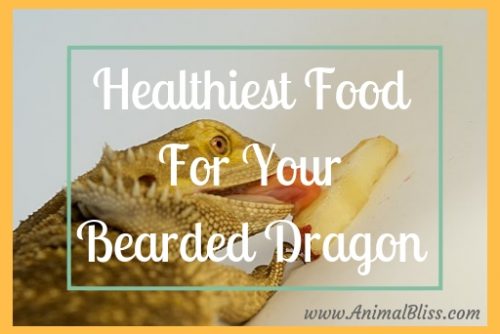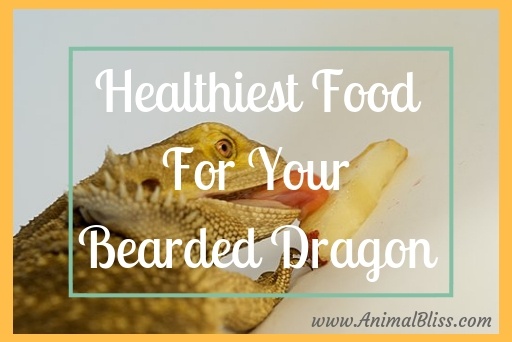Healthiest Food For Your Bearded Dragon
Just like you need to get your five-a-day and drink plenty of water, bearded dragons need to have a healthy, well-balanced diet too if they are going to maintain good health. Just like you, bearded dragons don’t want to get a muffin top either, and that’s why they appreciate a thoughtful owner that feeds them well. The healthiest food for your bearded dragon are listed in this article.

Suitable Foods for Bearded Dragons
A bearded dragon’s diet can be broken down into two main categories: insects, and vegetables. You like to get your protein fix in the form of nice, medium-rare steak, but the bearded dragon likes his in the form of a nice juicy cricket. Who are you to judge anyway?
Age is Not Just a Number
Bearded dragons are omnivores which means that they eat a broad variety of different things. With that said, their diets vary somewhat depending on their age.
What to Feed Young Bearded Dragons
Young bearded dragons are still growing and developing and therefore need to eat more insects than adult beardies. Young dragons should have a diet comprised of 80% insects and 20% veggies. You should take care that the insects you feed them are not too big. When feeding young bearded dragons, you should do so three times per day, fifteen minutes per session. In other words, each time you feed them, you feed them as many insects as they can eat within the fifteen minutes.
What to Feed Adult Bearded Dragons
Adult bearded dragons need a diet that is richer in fruit and vegetables than insects. If you feed an adult beardie too many critters, they’ll become overweight and develop a little pot belly which we are sure is neither what you or the beardie wants.
Learn How to Prepare a Sumptuous Insect Buffet
There are plenty of insects that your beardie can eat. Like other animals, however, your beardie could be fussy or have preferences. Perhaps your bearded dragon loves the crunchy delight of roaches, or the flavors of crickets – only time will tell.
Consider Insect Safety
One important thing to note is that you cannot throw any old bug into your bearded dragon’s tank. Household pests can contain parasites and pesticides that can make your beardie sick, which means that you shouldn’t go running around your garden with a fly swatter or a butterfly net catching insects, or throwing in that spider that’s been lurking in the corner of your bathroom all spring.
Safe insects for your bearded dragon to eat include:
- Black soldier fly larvae (aka Phoenix Worms or Calci worms)
- Butterworms
- Earthworms
- Crickets
- Locusts
- Dubia Roaches
- Redworms
- Superworms
- Silkworms
How to Buy and Keep Superworms
We know what you’re thinking – is there really a worm species named the superworm? Yes, yes there is. Is it the superhero of the worm world? We’re not too sure. However what we are sure about is that a handful of superworms every other day will give your bearded dragon exactly the protein fix that it needs.
Superworms, red worms, and other wormy insects are often sold in small plastic containers with air holes. The plastic that these are constructed from is usually quite thin, and therefore it is best for you to transfer the insects into another container. If you don’t, they can chew through the air holes and make a great escape.
RELATED:
Bearded Dragon Shedding Process: What to Expect
How to Buy and Keep Crickets and Locusts
Crickets, roaches, and locusts – oh my! You need to be careful about how you store these insects since they can chew through plastic and netting. Could you imagine anything scarier than thousands of insects taking over your home and finding crickets in your bed, in your shoes, etc.? We can’t!
Below are some pointers on how to buy and keep crickets and similar insects.
1. Buy a “Critter Keeper”
Critter keepers can be purchased from most pet stores for just a few dollars. You can transfer the crickets into them just before you prepare them for feeding your bearded dragon.
2. Store the Insects in a Large Plastic Container
Before moving the crickets and critters to the critter keeper, store them in a large plastic container. Critter keepers are not very big, so they will likely not hold all of the insects you are storing.
3. Label the Container!
Trust us on this one. The last thing you want is for your child to excitedly open the box thinking there is candy inside and then let out an eardrum piercing scream because thousands of crickets have jumped out.
4. Make Sure the Container is Opaque
Picture the scene: you’ve spent all day making a tajine, you’ve invited your best friends and their partners over for dinner. Then you discover that no-one has an appetite because they are so disgusted by the sight of thousands of locusts squirming around in a box. Many people are freaked out by insects so don’t make the mistake of storing them in a clear container box.
5. Think about the Temperature
Consider the temperature when storing insects. If you store them somewhere too hot or too cold, they will perish, meaning that you have wasted money and your bearded dragon has lost his lunch. Try to keep the temperature constant.
6. Try to Diffuse the Smell
Crickets and other locusts can be smelly so take that into consideration when thinking about where to store them. You can buy products that diffuse and get rid of the smell (not just cover it).
Learn How to Prepare Your Beardie a Salad
Bearded dragons can benefit from eating the same greens as you do – collard greens, arugula, mustard greens, you name it! Next time you are in the kitchen preparing your Caprese salad, all you need to do is set aside a little portion of the greens for your bearded dragon to enjoy and appreciate.
Vegetables for Bearded Dragons
Though bearded dragons love their greens, they cannot eat everything. Fortunately, there are many things that they can eat (over 50 different vegetables and salad products!) Click here for the full list of vegetables that are safe for bearded dragons.
Fruit for Bearded Dragons
Bearded dragons love vegetables, but there are also times where they prefer something a little sweeter.
For those occasions, there are plenty of beardie-friendly fruits.
For some ideas as to what you can prepare your bearded dragon in a fruit salad, click here for the full list of fruit items that are good for your beardie.
It seems like a lot to consider at first, but in next to no time you will have developed a routine for feeding your bearded dragon and a lot of this will seem like second nature!
~~~~~
GUEST POST: The Healthiest Food For Your Bearded Dragon
GUEST WRITER: Evelyn Lopez
*** Please Share ***
The Healthiest Food For Your Bearded Dragon Share on X![]()
MY QUESTION FOR YOU:
Do you have a bearded dragon?
*** Leave your comment below. ***
(It’s just sexy!)

Peace
DISCLOSURE: Animal Bliss is a participant in the Amazon Services LLC Associates Program, an affiliate advertising program designed to provide a means for us to earn fees by linking to Amazon.com and affiliated sites.
(In other words, we’ll get a very small (teeny tiny) commission from purchases made through links on this website.)
So, go on … Don’t be shy!
Buy Something BIG and Expensive!
Thank you!
😀
[amazon_link asins=’B0018CJNEI,B0002DHAWQ,B0006G5B0M,B07BL2TGLG,B07B3SWMF6,0793828872,0764145800′ template=’ProductCarousel’ store=’animblis-20′ marketplace=’US’ link_id=’ae4a83ed-def6-11e8-b650-c5e6bda8beec’]
😀
- 4 Tips for Maintaining Healthy Weight for Your Cat - December 20, 2019
- 8 Amazing Benefits of CBD for Dogs and Other Pets - December 12, 2019
- Kibble or Canned Pet Food? What Should Your Pet Be Eating? - December 9, 2019

